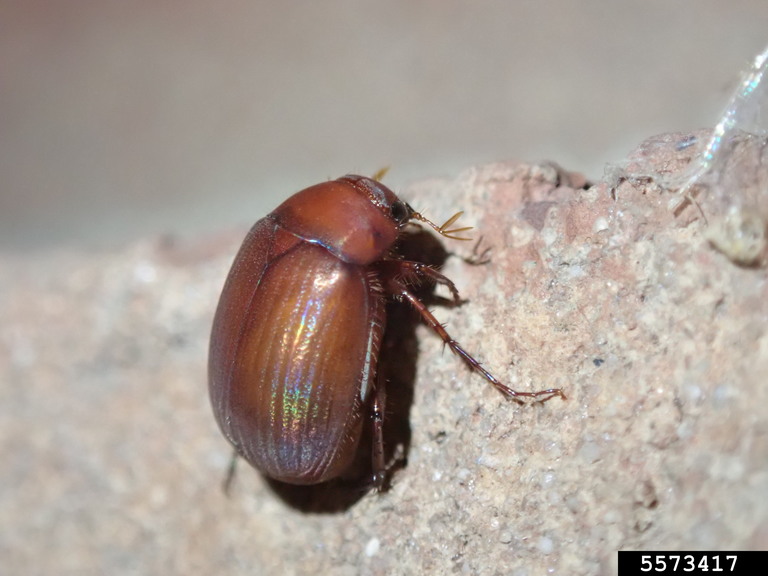How can I control the beetles that are eating my garden?

This summer seems to be a remarkable year for oriental beetles, Asiatic garden beetles, and Japanese beetles. These three introduced species are major garden pests, feeding on hundreds of plant species, including ornamentals, fruits, and vegetables. Learning to identify these species and the damage they cause is the first step towards mitigating their damage.
Identifying Common Introduced Garden Beetles
Oriental beetles

Oriental beetles could be considered quite beautiful if it weren’t for the damage they cause. They are metallic with brown and black markings on their wing covers, and have branched antennae. They are active in the garden from mid to late summer, feeding heavily on both vegetable crops and ornamentals. Although they primarily fly at night, oriental beetles can be found feeding during the day as well.
Asiatic garden beetles

Asiatic garden beetles are cinnamon-brown and about the same size and shape as a coffee bean. They do most of their feeding at night and are attracted to light, so you may find them around your home on window screens in the evening. If you notice large, irregular holes around the leaf edges of your plants but can’t find the culprit, there is a good chance you have Asiatic garden beetles. During the day the adult beetles lay low, hiding in the mulch or soil around the base of host plants.
Japanese beetles

Japanese beetles are easily recognized by their metallic green bodies which are accented on either side by white tufts of hair and shiny bronze wing covers. They will feed on over 400 plant species, consuming both flowers and leaves. Chewed leaves have a lace-like appearance as the beetles eat all of the leaf tissue except for the major veins. Japanese beetles are active during daylight hours.
Introduced Garden Beetle Life Cycle
Oriental, Asiatic garden, and Japanese beetles all spend their first year of development below the soil in grassy areas. The developing grubs feed on the roots of grass and other weeds until they emerge as adults in mid-summer. Fortunately, in New Hampshire these beetle species only produce one generation per year.
Monitoring For Introduced Garden Beetles
Roses and beans are often especially hard-hit, so it’s a good idea to monitor these plants for insects and damage starting early in the season.
In the home garden, one of the best control methods for beetles is handpicking. It is usually easier to handpick Japanese beetles in the morning and evening when the insects are less active. Oriental beetles can be found anytime during the day, and Asiatic garden beetles can be found at night.
Tachinid eggs
When handpicking, look to see if there are any white spots on Japanese beetles’ backs. Tachinid flies lay white eggs on Japanese beetle adults, and when those eggs hatch, the larva bore their way into the beetles and eventually kill them. If you notice tachinid eggs, make sure to leave those Japanese beetles alone to help boost natural enemy populations.
Pheromone Traps
Avoid using Japanese beetle pheromone traps. While these traps may attract and kill a large number of beetles, they may lure more to the garden than they catch. This can lead to increased damage to the plants surrounding the traps in the garden.
Chemical Control
A number of pesticides are registered for use on at least one of these species, but their effectiveness is often limited. Plants must be sprayed repeatedly because beetles are very good fliers and will continually reinvade areas with preferred host plants. Many of the most effective insecticides are also very toxic to bees and should not be applied when bees are actively foraging, or, in other words, when plants are flowering.
Got questions? The Ask UNH Extension Infoline offers practical help finding answers for your home, yard, and garden questions. Call toll free at 1-877-398-4769, Monday to Friday, 9 a.m. to 2 p.m., or e-mail us at answers@unh.edu.
Related Resource(s)
Do you love learning about stuff like this?
SUBSCRIBE TO Granite State Gardening newsletter
Got questions? The UNH Extension Yard and Garden Infoline offers practical help finding answers for your yard and garden questions.
Call toll free at 1-877-398-4769, Monday to Friday, 9 a.m. to 2 p.m., or fill out webform.

